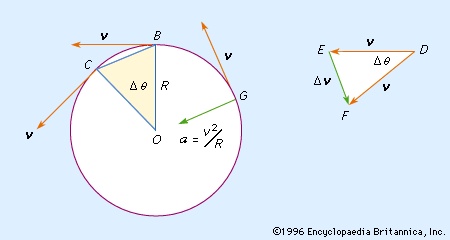uniform circular motion
physics

 motion of a particle moving at a constant speed on a circle. In the Figure-->
motion of a particle moving at a constant speed on a circle. In the Figure--> , the velocity vector v of the particle is constant in magnitude, but it changes in direction by an amount Δv while the particle moves from position B to position C, and the radius R of the circle sweeps out the angle ΔΘ. Because OB and OC are perpendicular to the velocity vectors, the isosceles triangles OBC and DEF are similar, so that the ratio of the chord BC to the radius R is equal to the ratio of the magnitudes of Δv to v. As ΔΘ approaches zero, the chord BC and the arc BC approach one another, and the chord can be replaced by the arc in the ratio. Because the speed of the particle is constant, if Δt is the time corresponding to ΔΘ, the length of the arc BC is equal to vΔt; and, using the ratio relationship, vΔt/R = Δv/v, from which, approximately, Δv/Δt = v2/R. In the limit, as Δt approaches zero, v2/R is the magnitude of the instantaneous acceleration a of the particle and is directed inward toward the centre of the circle, as shown at G in the Figure-->
, the velocity vector v of the particle is constant in magnitude, but it changes in direction by an amount Δv while the particle moves from position B to position C, and the radius R of the circle sweeps out the angle ΔΘ. Because OB and OC are perpendicular to the velocity vectors, the isosceles triangles OBC and DEF are similar, so that the ratio of the chord BC to the radius R is equal to the ratio of the magnitudes of Δv to v. As ΔΘ approaches zero, the chord BC and the arc BC approach one another, and the chord can be replaced by the arc in the ratio. Because the speed of the particle is constant, if Δt is the time corresponding to ΔΘ, the length of the arc BC is equal to vΔt; and, using the ratio relationship, vΔt/R = Δv/v, from which, approximately, Δv/Δt = v2/R. In the limit, as Δt approaches zero, v2/R is the magnitude of the instantaneous acceleration a of the particle and is directed inward toward the centre of the circle, as shown at G in the Figure--> ; this acceleration is known as the centripetal acceleration, or the normal (at a right angle to the path) component of the acceleration, the other component, which appears when the speed of the particle is changing, being tangent to the path.
; this acceleration is known as the centripetal acceleration, or the normal (at a right angle to the path) component of the acceleration, the other component, which appears when the speed of the particle is changing, being tangent to the path.- Stirling, Sir James
- Stirling, William Alexander, 1st Earl of, Viscount Of Canada, Viscount Of Stirling, Lord Alexander Of Tullibody
- Stirner, Max
- stirrup
- stirrup cup
- stirrup fixation
- stishovite
- Stitt, Sonny
- Stjepan Radić
- St. John's
- St. Johns, Adela Rogers
- St. Leger
- St. Lucia's Day
- stoa
- stoat
- stochastic process
- stock
- Stockbridge
- stock-car racing
- stock company
- Stockelsdorf faience
- Stockerau
- stock exchange
- Stockhausen, Karlheinz
- Stockholm